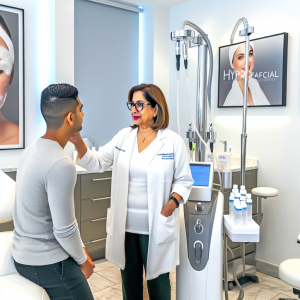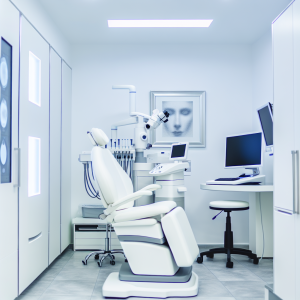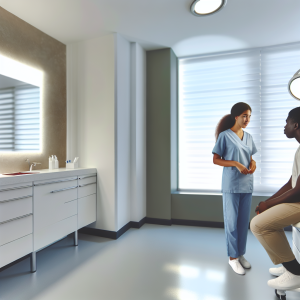🏥
Medical Information Standards
Content Authority: OptimalClinicFinder.com is a comprehensive medical directory platform connecting patients with qualified Acne Scar Treatment providers. Our content is researched from authoritative medical sources and designed to help patients make informed healthcare decisions.
How Laser Acne Scar Removal Works: Clinical Mechanisms and Technology
Laser acne scar removal operates on the principle of controlled thermal injury to stimulate the skin’s natural healing and remodeling processes. Fractional laser technology delivers precise columns of light energy into the dermis, creating microscopic treatment zones while leaving surrounding tissue intact. This fractional approach accelerates healing while minimizing downtime compared to traditional ablative resurfacing.
The two primary mechanisms driving scar improvement are immediate tissue ablation and long-term collagen remodeling. Ablative lasers like CO2 and erbium YAG vaporize damaged tissue at the surface while generating controlled heat in deeper layers. This thermal injury triggers fibroblast activation and new collagen synthesis, gradually filling depressed scars and improving skin texture over 3-6 months following treatment.
💡
Did You Know?
Clinical studies show that Acne Scar Treatment patients achieve excellent results when combined with professional-grade aftercare products.
Laser Technologies and Treatment Modalities
Modern laser acne scar removal utilizes several distinct technologies, each optimized for specific scar types and patient characteristics. Fractional CO2 lasers represent the gold standard for deep acne scarring, delivering 10,600nm wavelength energy that’s highly absorbed by water in skin tissue. These systems create controlled micro-injuries that stimulate aggressive collagen remodeling while maintaining rapid healing.
Erbium YAG lasers operating at 2,940nm offer a gentler alternative for patients with sensitive skin or lighter scarring. The erbium wavelength provides more precise tissue ablation with less thermal damage, resulting in faster healing but potentially requiring additional treatment sessions. Non-ablative fractional lasers like 1,550nm erbium glass create dermal heating without surface disruption, ideal for patients seeking minimal downtime options.
Treatment Protocols and Clinical Management
Successful laser acne scar removal requires comprehensive treatment planning based on scar morphology, skin type, and patient goals. The initial consultation includes detailed scar mapping using standardized classification systems like the Goodman and Baron scale. Digital photography and sometimes 3D imaging document baseline conditions and track progress throughout the treatment series.
Treatment protocols typically involve 3-6 sessions spaced 6-12 weeks apart, allowing adequate healing and collagen remodeling between treatments. Energy parameters are customized based on scar depth, skin thickness, and patient tolerance. Most providers begin with conservative settings and gradually increase intensity in subsequent sessions based on healing response and patient feedback. Combination approaches often incorporate multiple laser wavelengths or adjunctive treatments like microneedling or chemical peels.
💡
Quick Tip
Acne Scar Treatment works best when combined with healthy lifestyle choices for optimal results.
Expected Results and Treatment Timeline
Clinical studies demonstrate that laser acne scar removal can achieve 50-80% improvement in scar appearance, with results varying based on scar type and treatment parameters. Ice pick scars typically show the most dramatic improvement, while rolling scars and boxcar scars also respond well to fractional laser treatment. Patients generally notice initial improvements 4-6 weeks after the first treatment, with continued enhancement over 6-12 months.
The treatment timeline extends beyond the active treatment phase, as collagen remodeling continues for months following the final session. Peak results are typically achieved 3-6 months after completing the treatment series. Long-term follow-up studies show that improvements are generally stable, though some patients choose maintenance treatments every 12-18 months to optimize results.
Safety Considerations and Risk Management
Laser acne scar removal maintains an excellent safety profile when performed by qualified providers using appropriate protocols. Common side effects include temporary redness, swelling, and mild discomfort that typically resolve within 3-7 days. More significant complications like infection, scarring, or pigmentary changes occur in less than 2% of patients when proper techniques are employed.
Patient selection is crucial for minimizing risks, with certain conditions requiring special consideration or treatment modifications. Active acne must be controlled before laser treatment, and patients with darker skin types require modified parameters to prevent post-inflammatory hyperpigmentation. A history of keloid formation, current isotretinoin use, or certain autoimmune conditions may contraindicate treatment or require additional precautions.
Cost Analysis and Investment Considerations
The investment in laser acne scar removal reflects the advanced technology and specialized expertise required for optimal outcomes. Treatment costs vary significantly based on geographic location, provider experience, technology platform, and treatment complexity. Most patients require 3-6 sessions, making the total investment range from $1,200-4,800 for a complete treatment series.
⚠️
Safety First
Always consult a qualified medical professional before starting Acne Scar Treatment. Results vary by individual.
✓
Why Choose Acne Scar Treatment?
●
Clinically proven
●
FDA approved
●
Minimal downtime
●
Long-lasting
While laser acne scar removal is typically considered cosmetic and not covered by insurance, some patients may qualify for coverage if scarring significantly impacts psychological well-being or professional opportunities. Many providers offer financing options or payment plans to make treatment more accessible. When evaluating costs, patients should consider the long-term value compared to ongoing expenses for camouflage makeup or less effective treatments.
Provider Selection and Facility Standards
Choosing an experienced, qualified provider is the most important factor determining treatment success and safety. Board certification in dermatology or plastic surgery provides the foundational medical training necessary for safe laser procedures. Additional laser-specific training and certification from organizations like the American Board of Laser Surgery demonstrate specialized competency in laser applications.
Facility standards are equally important, with accredited medical facilities offering optimal safety and quality assurance. Look for providers who use FDA-cleared laser systems, maintain proper safety protocols, and provide comprehensive consultation and follow-up care. Patient reviews, before-and-after photos, and provider transparency about risks and expected outcomes help evaluate potential treatment providers.
Maximizing Results and Long-term Skin Health
Optimizing laser acne scar removal outcomes requires patient commitment to proper pre- and post-treatment care. Sun protection is absolutely critical, as UV exposure can compromise healing and increase pigmentation risks. High-quality mineral sunscreens with SPF 30 or higher should be used daily, starting 4-6 weeks before treatment and continuing indefinitely.
Post-treatment skincare focuses on supporting healing and maintaining results through gentle cleansing, appropriate moisturization, and gradual reintroduction of active ingredients. Many providers recommend specific product regimens including growth factors, peptides, or retinoids to enhance collagen production and maintain skin health. Regular follow-up appointments allow providers to monitor healing, address any concerns, and optimize long-term outcomes through additional treatments or skincare modifications.
📚 Medical Authorities & Professional Standards
All Acne Scar Treatment procedures should be performed by licensed medical professionals following established clinical guidelines and safety protocols.
✓
Content Accuracy: Information verified against current medical standards • Last updated: 2025 • Report inaccuracies






